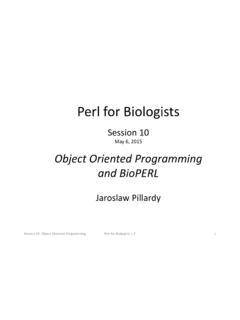Transcription of Genotyping By Sequencing (GBS) Method Overview
1 Genotyping By Sequencing (GBS) Method OverviewRJ Elshire, JC Glaubitz, Q Sun, JV HarrimanES Buckler, and SE Background/Goals GBS lab protocol Illumina Sequencing review GBS adapter system How GBS differs from RAD Modifying GBS for different species Workflow in our labTopics PresentedBackgroundGenotyping by Sequencing (GBS) in any large genome species requires reduction of genome Restriction Enzymes (REs)I. Target enrichment Long range PCR of specific genes or genomic subsets Molecular inversion probes Sequence capture approaches hybridization based (microarrays)
2 *Technically less challenging* Methylation sensitive REs filter out repetitive genomic fractionQTL are often located in non coding regionsVgt1, Tb, B regulatory regions 60 150kb from geneExon Exon ExonExonExon captureMap large numbers ofgenome wide markersQTLC reate inexpensive, robust multiplex Sequencing protocolLow coverageSequencing Illumina GAInformatics PipelinAnchor markers across the genomeImpute missing dataCombine genotypic & phenotypic data for GS and GWASOur goal is to create a public Genotyping /informatics platform based on next generation sequencingOpen Source Method available for anyone to use / modify.
3 Analysis pipeline details and code are public. Promote dataset compatibility. Method published in PLoS ONEto promote accessibility. Genotype calls publically available.< 450 bpRestriction site( ) sequence tagLoss of cut siteSample1 Overview of Genotyping by Sequencing (GBS) Focuses NextGen Sequencing power to ends of restriction fragments Scores both SNPs and presence/absence markersSample2 Reduced sample handling Few PCR & purification steps No DNA size fractionation Efficient barcoding system Simultaneous marker discovery & Genotyping Scales very wellGBS is a simple, highly multiplexed system for constructing libraries for next gen sequencingGBS 96 plex Protocol( Overview )1.
4 Plate DNA & adapter pair2. Digest DNA with RE3. Ligate adaptersNow at 384 plexGBS Adapters and EnzymesBarcodeAdapter Sticky Ends Barcode(4 8 bp)CommonAdapterP1P2 ApeKI G CWGCPstICTGCAGEcoT22I ATGCAT5 3 Restriction EnzymesIllumina Sequencing Primer 2 Illumina Sequencing Primer 1 GBS 96 plex Protocol( Overview )..1. Plate DNA & adapter pair5. PCRP rimers2. Digest DNA with RE3. Ligate adaptersClean up4. Pool 96 Digestion/LigationReactions (n=94)GBS Library PRC primers:InsertGBS 96 plex Protocol( Overview )..1. Plate DNA & adapter pair5. PCRP rimers2.
5 Digest DNA with RE3. Ligate adapters4. Pool 96 DNA aliquots 6. Evaluate fragment sizesClean upClean upPerform Titration to Minimize Adapter Dimers Before SequencingSize StandardsLibraryAdapterDimer1500 bp15 bpNOTE: Done once with a small number of dimers constitute only of raw sequence readsFluorescense intensityTimeTimeOptimal adapter amountSmall Fragments are Enriched in GBS Libraries Total Fragments0%5%10%15%20%25%30%35%40%050100 1502002503003504004505005506006507007508 00850900950100010000000 REFGENOMEIBMApeKI fragment size (bp)>10000B73 RefGen v1 IBM (B73 X Mo17)
6 RILs010000020000030000040000050000060000 07000008000009000001000000384 plex GBS Results for Maize ReadsMean read count per line = 528, = channelsSolid Phase OligosIllumina Sequencing by Synthesis ReviewFlow cell with bound oligosDenatured Library Cluster Formation Amplifies Sequencing SignalBridge AmplificationLinearizationACGTGGCACGTGCT GTGP1 primerCACGTGCTGGAACGTGCTGCGTTG TGCTGCAS equencing by SynthesisFlowcellHiSeq 2000 GACGTGCTGACGTGGCTCACGTGCTGGTNACGTGGCTACG TGGCTACGTGGCT In Phase Out of Phase Read 1 GBS captures barcode and insert DNA sequence in single readInsert DNAB arcodeSequencing Primer 1 Sequencing Primer 2 IlluminaRead 1 Read 2 Sequencing Primer 1 BarcodeRE cut
7 SiteInsert DNAGBSV ariable Length GBS Barcodes Solves Sequence Phasing Issues First 12 nt used to calculate phasing. Algorithm assumes random nt distribution. Incorrect phasing causes incorrect base DNA Good design and modulating the RE cut site position with variable length barcodes produces even nt distribution. BarcodeRE cut siteGBSI nsert DNARead 2 Read 1 Invariant GBS barcodes cause loss of signal GBS Sequencing significant GBS technical issue?DNA qualityDifferent Ends50%Same Ends50%100%LigationLigationPCRGBSS tandardGBS does not use standard Y adaptersDenatured library Flow Cell with Bound OligosSame ended Fragments Do Not Form ClustersBridge AmplificationCluster Formation & Linearization No P1 bindingsiteCleaved from surface< 450 bpRestriction site( )
8 Sequence tagLoss of cut siteSample1 GBS Focuses NextGen Sequencing power to ends of restriction fragments Scores both SNPs and presence/absence markersSample2 DigestLigate adaptersPoolRandom shearSize selectLigate Y adaptersPCRRADGBSR eferenceDavey et al. 2011 Modifying GBSC onsiderations for using GBS with new species and / or different Modify the GBS Protocol? More markers Fewer markers (deeper sequence coverage per locus) Increase multiplexing More genome appropriate (avoid more repetitive DNA classes) Other novel applications ( , bisulfitesequencing).
9 Genome Sampling Strategies Vary by SpeciesDependent on Factors that Affect Diversity: Mating System(Outcrosser, inbreeder, clonal?) Ploidy(Haploid, diploid, auto or allopolyploid?) Geographical Distribution(Island population, cosmopolitan?)Other Factors Genome size The size of the genome has some bearing on the size of the fragment pool. Amount of repetitive DNA directly correlated with genome size. Genome composition The composition of the genome can affect the frequency and distribution of the cut large genomes with methylation sensitive restriction base cutter6 base cutterMethylatedDNAU nmethylatedDNAGBS LibrarySequenced FragmentsScrub jayVoleGiantsquidDeer Mouse TunicateYeastSolitary BeeGrapeMaizeCacaoRiceRaspberryBarleyCas savaGooseSorghumCassavaShrub willowOptimizing GBS in New SpeciesChoosing Appropriate Restriction Enzymes Life is like a bowl of chocolates.
10 GoosePstIGiant SquidApeKIDeer MouseApeKIPstIShrub WillowApeKIPstIEcoT22 IGBS Adapter DesignBarcode Design Considerations Barcode sets are enzyme specific Must not recreate the enzyme recognition site Must have complementary overhangs Sets must be of variable length Bases must be well balanced at each position Must different enough from each other to avoid confusion if there is a Sequencing error. At least 3 bp differences among barcodes. Must not nest within other barcodes No mononucleotide runs of 3 or more adaptersGBS SNP calls in Sorghum TNNNNNNNNNNS10_158101G/A10 GNNAGNNNNNNNGAANGGNS10_158101G/A10 GANAGANNNGNGNNNNGGNS10_163724G/A10 GANANNNGNNGNNNNNGNGS10_163929T/G10 GTNTGNGNNGGNGTTTNGNS10_163931C/T10 TCNCTNTNNTTNTCCCNTNS10_180445G/A10 GAGNGAGGGNGNGAANGGGS10_209049C/G10 NGCSCGCCCNCCNCGGNCNS10_209231G/A10 NAGAGAGGNNGGGNAAGGNS10_214941C/T10 CNNTNNNNCNCNNNNNNCCS10_234260T/G10 TNTNTGTNTTTTTNNGTNTS10_234260T/G10 TGTGTGNTTTTTTNGGTTTS10_238937G/A10 NANANNGGGNGNNNANNNNS10_252729G/T10

